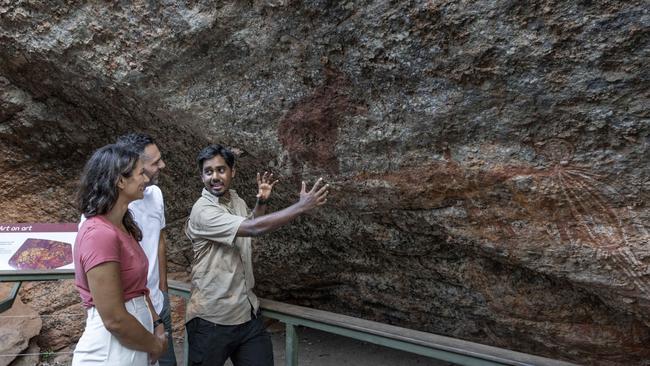Australian travellers spent about $3bn on Indigenous tourism in 2022, more than double that of international visitors
Australian travellers are embracing Aboriginal culture in huge numbers, especially in the Northern Territory, spending billions of dollars on Indigenous tourism.

As debate about artistic integrity and the Indigenous voice to parliament rages, one thing seems clear: Australian travellers are embracing Aboriginal culture in huge numbers.
According to a survey by Tourism Research Australia, the number of domestic travellers who engaged in Indigenous cultural activities across the country increased by almost 30 per cent from pre-Covid 2019 to 2022.
From 2021 to 2022 in the Northern Territory, home to bucket-list destinations such as Uluru and Kings Canyon in the Red Centre, and Kakadu National Park and the Tiwi Islands in the north, that growth was almost 60 per cent.
From the recently opened Laundry Gallery in Darwin, which hosts language lessons and painting classes as well as exhibitions, to tours of some of Kakadu’s 5000 known rock art sites, business appears to be booming.
Australians spent more than $3bn on Aboriginal tourism activities across the continent in 2022, compared with $1.3bn by international visitors, about 130% more.
Bininj man James Morgan, a park ranger who founded Yibekka Kakadu Tours early last year, ventured into business with the aim of creating jobs for Aboriginal people while passing on traditional knowledge to visitors.

“Most people who come to Kakadu will never meet a local Bininj person,” he said.
“Most tour guides are non-Indigenous. I wanted to be able to ensure with all the tourism that goes through Kakadu that Bininj people are able to take advantage of that opportunity, address employment issues and eventually address some of our housing issues.”
In the first year of Yibekka’s operation, Morgan ran small-group tours six days a week, which generated work for four locals. This year, he’s set up an extra enterprise with the potential to employ up to 100 Bininj people in casual conservation, tourism, media, research and construction work.
Yibekka is Kunwinjku word that loosely translates as “you listen” or “you feel”.
Morgan’s tours take visitors to rock art that is thousands of years old but he says tourists are often surprised to learn some of the paintings were made in the 1960s. The revelation helps to emphasise that traditional culture is alive and continuing, he says.
“Keeping strong in culture is a way you keep people strong as individuals … There are so many different benefits to having more people in the Aboriginal tourism sector. You have people constantly telling their story and it makes them stronger ... it builds a sense of pride.”
“We know people who visit the Territory want to experience Aboriginal culture first-hand and that’s why we’re working hard to develop more First Nations tourism experiences,” said NT Tourism Minister Nicole Manison.
She cited the forthcoming National Aboriginal Art Gallery in Alice Springs and Larrakia people’s cultural centre in Darwin as examples of how the government has invested in the sector.
For more on the NT’s Indigenous tourism offerings, read the cover story in The Weekend Australian’s Travel + Luxury section.


To join the conversation, please log in. Don't have an account? Register
Join the conversation, you are commenting as Logout